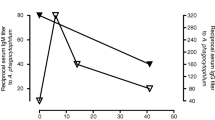Abstract
Some epidemiological and clinical characteristics ofPityriasis rosea Gibert has led us to hypothesize that this disease may be the clinical manifestation of an infection caused by legionellas. We have thus tested the sera of 36 patients ill withPityriasis rosea and 19 controls forLegionella pneumophila serogroup 1–6 andLegionella micdadei antibodies. These, who had the same age and sex distribution as study patients, were receiving treatment for other diseases in the same ward. Also tested were 200 sera from the voluntary blood donors from the same region as study patients.Legionella micdadei antibodies were detected in 12 (33.3%)Pityriasis rosea cases and in one (5.2%) control. They were significantly more common in Pityriasis rosea cases than in either controls or voluntary blood donor population. The findings to date encourage continued research into the causative relationship between theLegionella micddadei infection and the onset ofPityriasis rosea Gibert.
Similar content being viewed by others
References
Gibert CM. Traité pratique des maladies de la peau et de la syphilis, 3d ed. Paris: Plon, 1860.
Pityriasis rosea. In: Rook A, et al. (eds), Textbook of dermatology, 4th ed. Oxford: Blackwell, 1986: 720–723.
Aoshima T, Komura J, Ofuji S. Virus-like particles in the herald patch. Dermatologica 1981; 162: 54–65.
Bonafe JL, Icart J, Perpere M, Oksman F, Divoux D. Etude histopathologique ultrastructurale, immunologique et virologique duPityriasis rose de Gibert. Ann Dermatol Venereol 1982; 109: 855–861.
Garcia e Silva L, Gardner PS.Pityriasis rosea: A virological study. Br J Dermatol 1968; 80: 514–515.
Hudson LD, Adelman S, Lewis CW.Pityriasis rosea. Viral complement fixation studies. J Am Acad Dermatol 1981; 4: 544–546.
Markham SF. A search for filterable viruses in cutaneous disease of unknown etiology. Arch Derm Syph 1940; 41: 261–264.
Niles DH, Klumpp MM.Pityriasis rosea: Review of the literature and report of two hundred and nineteen cases, in thirty eight of which convalescent serum was used. Arch Derm Syph 1940; 41: 265–294.
Raskin J. Possible dermatropic virus associated withPityriasis rosea. Acta Derm Venereol (Stockh) 1968; 48: 474–481.
Wright AD, Francis RD.Pityriasis rosea: An etiologic study. Arch Dermatol 1961; 84: 87–89.
Marshall JPityriasis rosea: Review of its clinical aspects and discussion of its relationship to pityriasis lichenoides et varioliformis acuta and parapsoriasis guttata. S Afr Med J 1956; 30: 210–218.
Gjenero-Margan I, Drazenovic V, Vrbica J, Vjerda R, Aleraj B, Borcic B. Epidemija legionarske bolesti u jednom hotelu. Lij Vjes 1989; 111 (3): 81–84.
Gjenero-Margan I, Klicmanic Z, Grandic L, Drazenovic V, Lovric E, Petric I, Sobot S. The shipyard comprimated air system as a possible means of transmission of legionella infection. In: Pomorska medicina V, Pomorska bibilioteka 39, 1990: 237–241.
Gjenero-Margan I. Legionarska bolest i protuepidemijske mjere u hotelima. In: Zbornik radova seminara Suvremeni pogledi o zdravstvenoj sanitaciji u Republici Hrvatskoj, Malinska 1993: 67–71.
Smalcelj R, Gjenero-Margan I, Slavicek J, Drazenovic V. Antibodies toLegionella pneumophila and Legionella micdadei in patients at Hemodialysis unit. Int J Artif Organs 1993; 16 (6): 392.
Bjornberg A, Hellgren L.Pityriasis rosea: A statistical, clinical, and laboratory investigation of 826 patients and matched healthy controls. Acta Derm Venereol (Stockh) 1962; 42 (suppl 50): 1–68.
Chuang TY, Ilstrup DM, Perry HO, Kurland LT.Pityriasis rosea in Rochester, Minnesota, 1969 to 1978: A 10-year epidemiologic study. J Am Acad Dermatol 1982; 7: 80–89.
Messenger AG, Knox EG, Summery R, Muston HL, Ilderton E. Case clustering inPityriasis rosea: Support for role of an infective agent. Br Med J 1982; 284: 371–373.
PHLS Surveillance Centre. Report on Legionaires' disease. Br Med J 1986; 293: 680–682.
Bjornberg A.Pityriasis rosea. In: Fitzpatrick TB, et al. (eds), General medicine, 3th ed. New York: McGaw-Hill Book, 1987: 982–980.
Bercovier H, Fattal B, Shuval H. Seasonal distribution ofLegionnellae isolated from various types of water in Israel. Isr J Med Sci 1986; 22: 644–646.
Bhopal RS, Fallon RJ. Seasonal variation of Legionnaires' disease in Scotland. J. Infect 1991; 22 (2): 153–160.
Morton N, Swartz MD. Clinical aspects of Legionnaires' diseasease. Ann Intern Med 1979; 90: 492–495.
Petricevic I. Legionarska bolest: Nova epidemijska infekciozna bolest civiliziranog svijeta. Lij Vjes 1979; 101: 506–508.
Petričević I. Legionarska bolest u nasih bolesnika. Lij Vjes 1980; 102: 181–184.
Zamotaev IP, Sokolova VI, Kamnev Iu V, Bormotova MS. Sluchai uspeshnoi antibiotikoterapii bolezni legionerov s porazheniem legkikh i serdtsa. Antibiot Khimioter 1990; 35 (6): 43–45.
Sakvarelidze LA, Nersesov VA, Mgeladze G Iu, Gamtsemlidze PS, Barnabishvili NO. Sluchai zabolevaniia legionellezom v Tbilisi. Zh Mikrobiol Epidemiol Immunobiol 1990; 1: 42–45.
Daniels WB, Grennan HA. Pretibial fever an obscure disease. J A M A 1943; 122: 361–365.
Tatlock H. A rickettsia-like organism recovered from guinea pigs. Proc Soc Exper Biol and Med 1944; 57: 95–99.
Hebert G, Steigerwalt AG, Brenner DJ.Legionella micdadei species nova: Classiciation of a third species of Legionella associated with human pneumonia. Curr Microbiol 1980; 3: 255–257.
WHO. Epidemiology prevention and control of legionellosis: Memorandum from a WHO meeting. WHO Bulletin 1990; 68: 155–164.
Doebbeling BW, Ishak MA, Wade BH, Pasquale MA, Gerszten RE, Groschel DHM, Kadner RJ, Wenzel RP. NosocomialLegionella micdadei pneumonia: 10 years experience and a case-control study. J Hosp Inf 1989; 13: 289–298.
Bozeman FM, Humphries JW, Cambell JM. A new group of Rickettsia-like agents recovered from guinea pigs. Acta virol 1968; 12: 87–93.
Author information
Authors and Affiliations
Rights and permissions
About this article
Cite this article
Gjenero-Margan, I., Vidovic, R. & Drazenovic, V. Pityriasis rosea gibert: Detection ofLegionella micdadei antibodies in patients. Eur J Epidemiol 11, 459–462 (1995). https://doi.org/10.1007/BF01721233
Accepted:
Issue Date:
DOI: https://doi.org/10.1007/BF01721233




